Bea Lines
by H.G. "Bea" Hyve
Reprinted from "Crown Jewels of the Wire", December 1986, page 18
New York is the state to which we will travel this time, to interview Jeff McCurty of Millbrook. If I had to describe Jeff in one
word, it would be
"neat". Not only is he an all-around neat guy, in the sense of being
terrific, but he is also neat in the true sense of the word. Anyone who has ever
received a letter from Jeff knows that his writing looks almost as though it was
done in a print shop or on a typewriter. Plus, his display material is done so
beautifully, you'd swear he'd had them printed; but he does it all by hand.
He has an incredible talent.
Let's find out a little about Jeff. He was born in Poughkeepsie, NY on
January 29, 1954 and lived in Hyde Park, NY for his first 25 years. He then
moved to his current address in Millbrook, which is about 10 miles from CT. He
works for the Stats of NY as a social worker at a developmental center for the
mentally retarded and various multipli-handicapped people. He's been there
almost 8 years, and greatly enjoys it. Jeff says, "I think the cerebral
palsy and autistic people have taught me the most. Collage was interesting and
important, but it can only teach just so much. We now have a population of 1,500
residents which makes it the largest in New York and one of the ten largest in
the country. The position offers me the challenge to deal with people who are
handicapped and the insights to realize just how fragile and important a human
life can be."
Jeff first became interested in insulators in 1972 while a senior in high
school. He'd collected bottles for a short while before the insulator bug bit
him. His first introduction to insulators came when his mom read a magazine
article stating that they were worth money. He really couldn't guess why anyone
would pay money for those ugly brown things on the telephone poles. Soon after, however,
he and one of his brothers went walking along the
local railroad tracks... and up the poles.... to get some of these
insulators. He then realized that they came in glass too, with many shapes,
colors, and had different names on them. After doing this a few times, he really
got the bug and had to have more. Quite by accident he came across one of
Tibbits' books in a store and went crazy seeing all the drawings. From there he
soon found out about Crown Jewels magazine, and subscribed immediately.
Approximately 6 months after his first walk along the tracks, he went to his
first show in Middletown, NY, and spent every penny he had. Jeff says,
"This show was held twice a year and for the next 2 years or so, was what I
lived for. It was really exciting and educational, seeing so many great
insulators and knowing other people thought so too.
"My first national in 1976 really opened my eyes to so much. I got to
mast and talk with people and a few of them are still very close friends. Over
the next 5 or 6 years, I primarily attended 1 or 2 shows a year, and
corresponded with other collectors the rest of the time. Unfortunately, with
college and job responsibilities, my overall participation in the hobby slowed
down a bit. Actually, I think it's the people I know and the friendships I have
made through the hobby that have become the most important. They've really
helped me a lot during some of life's everyday routine problems."
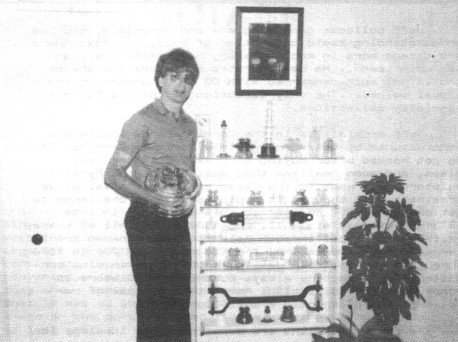
Jeff with some of his Pyrex collection. The Pyrex 441
in his hand has a small
top; 1 of only 2 known.
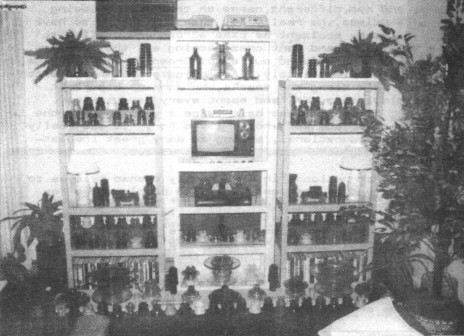
Living room shelf units with various collections.
Jeff collects general glass and porcelain, and has an outstanding basic
collection of both, but says there are dozens more in each category he doesn't
have, and has never seen. He concentrates on colors and shapes, and is not much
concerned with CD or U numbers or individual values. The only exception to this
is for his specialty collections.
Jeff specializes in the Corning-Pyrex insulators manufactured by the Corning
Glass Works in Corning, NY. He got hooked after buying a Pyrex 662 in carnival
glass, and soon realized that most all of the Pyrex insulators were made in the
clear and the carnival glass treatment. He thought it would be a great challenge
to get one of each. He started this specialty in late 1973 and it took him until
mid-1980 to get all of the available pin-types in both colors. He purchased the
3 largest Pyrex insulators, #'s 553, 663, and 701 in 1974 through an ad in Crown
Jewels, and all are in mint condition. Jeff says he always purchases
insulators to complement his collection; never in the hopes of reselling. He's
strictly a collector.
As far as go-withs are concerned, his ideology is to treat the apartment as
one unit to house his collections.. It is furnished with very contemporary
furniture, lots of plants, and all of his different antique items throughout. Insulators
are in the living room, den, and bedroom. The kitchen is full of glass
refrigerator dishes (1935-1945) as canisters, canning jars (1910-1930), milk
bottles (1940-1950), flat and sad irons, and Corning-Pyrex glass cookware
(1945-1975). The bathroom has 5 shelves of patent medicine bottles. Also around
the apartment are about a dozen barn, wagon, and railroad lanterns. He recently
started collecting toy automobiles, and he has several from 1920-1960.
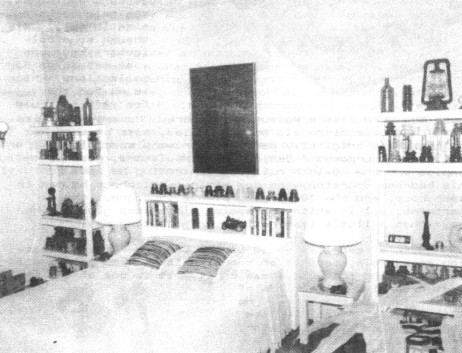
Bedroom with various collections.
In the insulator category, he also collect. glass capacitor bushings, because
he finds their shapes and colors fascinating. Most are made of crude amber
glass, but their simplicity is neat. He has 2 dark yellow-green ones that are
beautiful, containing thousands of tiny air bubbles. The rarest one is of very
light green vaseline glass, full of swirls and bubbles. These bushings are
throughout the apartment because he feels they complement the other items so
well. They become quite a conversation starter because so few people know what
they are. The nicest compliment Jeff ever received was that it was so
interesting to be in his apartment... wherever the person looked, there was something
unique to look at.
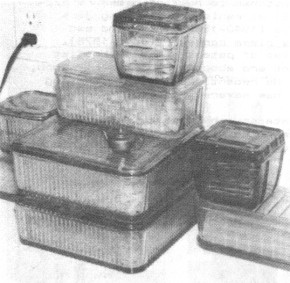
Various colored refrigerator dishes
used for kitchen counter storage.
Jeff doesn't like decorations or knick-knacks, as such. He's furnished his
apartment with a variety of items he finds interesting and different. He says
that the insulator shows, local antique shops, and flea markets are so fascinating
compared to shopping at the neighborhood plastic mall. Although some collectors
have one room set aside for collections, which is ok for them, for Jeff it would
seem too much like a museum atmosphere. He tries to live with his collections
all around. Also, most of what he collects was originally designed for very
specific, utilitarian purposes. Besides the insulators, good examples are the
18-inch railroad car spring he uses for his bedroom doorstop, the one antique
telephone he has in each room, and the 10 hanging plants throughout the
apartment, all in white depression glass lamp globes. He says that a little
imagination can go a long way.
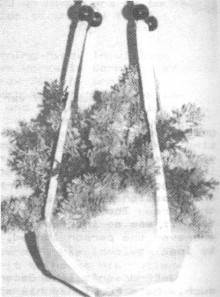
Depression glass lamp globe used as a planter.
Jeff's favorites would be his Corning-Pyrex collection as a whole, because of
the time it took to get it all together, and the uniqueness of it. It is one of
the two most extensive collections of Pyrex glass in the hobby. He lists his
main "want" as the Corning-Pyrex #660 insulator. There is currently
only one known, and Jeff's research has shown it to be an experimental unit
designed in 1924, of which only 300 were produced. He laments that the odds
aren't exactly in his favor. He has 420 insulators in his collection, and 35
capacitor bushings.
Jeff displayed his Corning-Pyrex collection at the national in Herkimer, NY
in 1980. This was his first display, plus the very first time all of his Pyrex
was together, so to speak. (At the time, he was living in a studio apartment and
many of his insulators were in storage). He won First Place Specialty and the
Milholland Education Award. After adding a few items and doing a lot of research
at the Corning Glass archives, he displayed again at the national in Rochester,
NY in 1983. He was given First Place Specialty, the Milholland Education Award,
and the George C. Scott Probe Award. At the national in Saratoga Springs, NY, he
displayed yellow glaze porcelain insulators, which won the First Place Porcelain
and the Milholland Education Awards. Jeff states that, "I was very honored
each time because I didn't put the displays together to win anything, but to
share the collections and the historical information that goes along with them.
The awards show my work was appreciated." Jeff's other hobbies include
reading... especially science fiction and historical novels. He also finds
bowling relaxing and a lot of fun.
Jeff was involved in putting together the Seldom Seen Display this summer at Saratoga
Springs, NY, as one half of the partnership that brought together the most
beautiful, expensive, unique, colorful, delightful, and impressive display of
glass (and porcelain) insulators ever seen. Never before has such a gorgeous
collection of insulators from all over the world been assembled in one place.
Not only was it a dream come true for delegates to the national, but it was an
education for newly-interested collectors, and the general public, too.
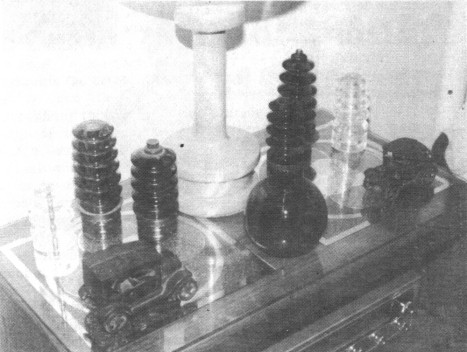
Capacitor bushings and cast iron vehicle toys.
The Seldom Seen Display showed to all the world just what there is in
insulator-land. Jeff can truly be proud of his part in such an endeavor.
Another big way in which Jeff has contributed to our hobby is through his
superbly-written articles for Crown Jewels. Numbering 7 so far, they have
given us a greater insight into Corning-Pyrex insulators. The average person
probably cannot realize the amount or time and energy that goes into a research article...
so Jeff is to be commended for having given the hobby so many fine articles.
In closing, Jeff says, "After being involved in this hobby for the pest
14 years, I can truthfully say that I am most impressed by the people in it.
Sometimes we probably appear to be nuts to be collecting what we do, but in this
constantly-updated, throw-away society, it's really great that we are saving
this part of history through the actual insulators and go-withs. Millbrook is
spending about one million dollars to put the majority or the wires underground
over the next 5 years. Change is constantly around us. One thing I hope never
changes in this hobby is the attitude or people helping people. This is an
important social organization in my life, as I think it is for most collectors.
I would like to thank all or the collectors and dealers who have helped me over
the past several years. To continue my support of the hobby, in July I started
my 3-year term as Eastern Region Vice President of the NIA. I still have a great
deal to learn, but I'm looking forward to the challenge. It's a whole new
chapter for me."
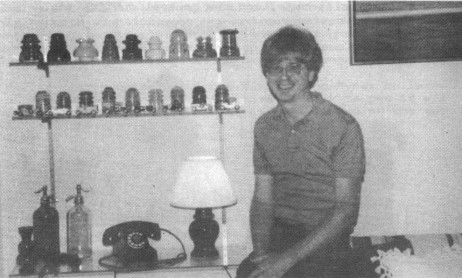
"Waiting for a call from Dan Wagner
telling me he's tired of his Pyrex 660!"
Jeff is a nice person to know, and a loyal and good friend. I always look forward
to seeing him each summer at the national. He's truly a "neat" person!
|
